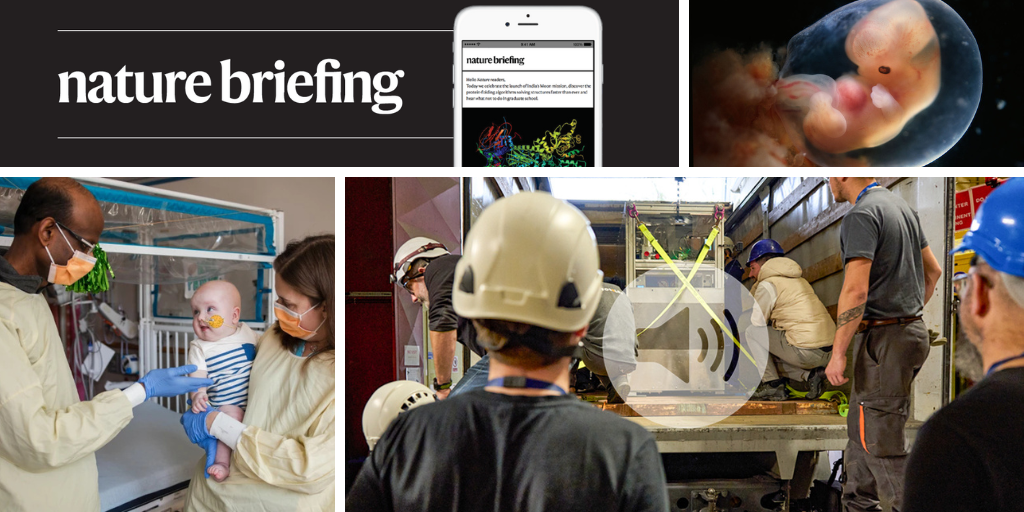You have full access to this article via your institution.
Hello Nature readers, would you like to get this Briefing in your inbox free every day? Sign up here.

Baby KJ Muldoon, who was born with a genetic disease that affected his ability to metabolize proteins, is the first person to receive a bespoke CRISPR treatment. Credit: Children’s Hospital of Philadelphia
A baby boy with a devastating genetic disease is thriving after becoming the first known person to receive a bespoke, CRISPR therapy-for-one. KJ Muldoon, now almost 10 months old, received three doses of a gene-editing treatment designed to repair his specific disease-causing mutation, which impaired his body’s ability to process protein. While Muldoon appears healthy, it is too soon to use the word “cure”, says paediatrician Rebecca Ahrens-Nicklas. “This is still really early days.”
Reference: New England Journal of Medicine paper
Researchers have coaxed embryonic stem cells to grow into fluid-filled amniotic sacs roughly the same size as a four-week-old sac surrounding a developing embryo. The model sacs, which expanded to some 2 centimetres wide over a period of three months, could be used to study the protective structure. Researchers extracted and analysed the fluid inside model sacs and found that it was rich with proteins and metabolites important for fetal health and growth.
Groups of large language models (LLMs) playing simple games can develop social norms. After several rounds of a ‘game’ that paired copies of the LLM Claude together and asked them to choose a letter from the alphabet, pairs began selecting the same letter. This suggests that the LLMs developed a collective bias — a type of social norm. The formation of collective biases could result in harmful biases, says complexity scientist and study co-author Andrea Baronchelli, even if individual agents seem unbiased.
Reference: Science Advances paper
Question of the week
Nature has launched its seventh global survey of science, technology, engineering and mathematics doctoral students. Tell us about why you decided to pursue a PhD or other doctorate, what you love about your supervisor or how they or your programme could do better — anonymously, of course. Enter, and you could have a chance to win £250 or equivalent in your local currency.
Features & opinion
Pharmacologist Lorna Ewart jokes that in 2012, in the early days of organ-on-a-chip technology, she was initially “laughed out of the room” by colleagues after making a toxicity-testing pitch. The tune has since changed. Last month, the US Food and Drug Administration (FDA) announced plans to phase out, within the next 3–5 years, animal testing for new drug candidates approaching the clinic. Weeks later, the National Institutes of Health said it was also deprioritizing animal models in biomedical research. Ewart says she was “taken aback by the boldness of the roadmap”. Funding is a big problem, and some toxicologists are concerned — for example, the Society of Toxicology just released a statement that they are concerned about the speed at which this is going. Nevertheless, it’s possible, says Ewart, who is now chief scientific officer at organ-on-chip company Emulate. “There’s a tremendous amount of work to be done but some huge opportunities ahead.”
Nature Reviews Drug Discovery | 5 min read
A place of remembrance is slowly forgotten in the latest short story for Nature’s Futures series.
Physicists have developed a portable ‘trap’ to contain antimatter and tested it by driving it on the back of a truck around the grounds of CERN, Europe’s particle physics laboratory. Their system is a step forward in efforts to transport particles made at CERN’s ‘antimatter factory’ to other labs, something currently impossible due to antimatter’s fragility. “We built it so that it fits through a regular door,” says particle physicist Christian Smorra. “You could even take it home with you if you want. You should check though that the floor holds — it still weighs about 900 kilograms.”
Nature Podcast | 30 min listen
Subscribe to the Nature Podcast on Apple Podcasts, Spotify or YouTube Music, or use the RSS feed.
Today Leif Penguinson is running with a herd of wild goats in the foothills of the Zagros Mountains, Iran. Can you find the penguin?
The answer will be in Monday’s e-mail, all thanks to Briefing photo editor and penguin wrangler Tom Houghton.
This newsletter is always evolving — tell us what you think! Please send your feedback to [email protected].
Thanks for reading,
Flora Graham, senior editor, Nature Briefing
With contributions by Jacob Smith and Smriti Mallapaty
Want more? Sign up to our other free Nature Briefing newsletters:
• Nature Briefing: Careers — insights, advice and award-winning journalism to help you optimize your working life
• Nature Briefing: Microbiology — the most abundant living entities on our planet — microorganisms — and the role they play in health, the environment and food systems
• Nature Briefing: Anthropocene — climate change, biodiversity, sustainability and geoengineering
• Nature Briefing: AI & Robotics — 100% written by humans, of course
• Nature Briefing: Cancer — a weekly newsletter written with cancer researchers in mind
• Nature Briefing: Translational Research — covers biotechnology, drug discovery and pharma


